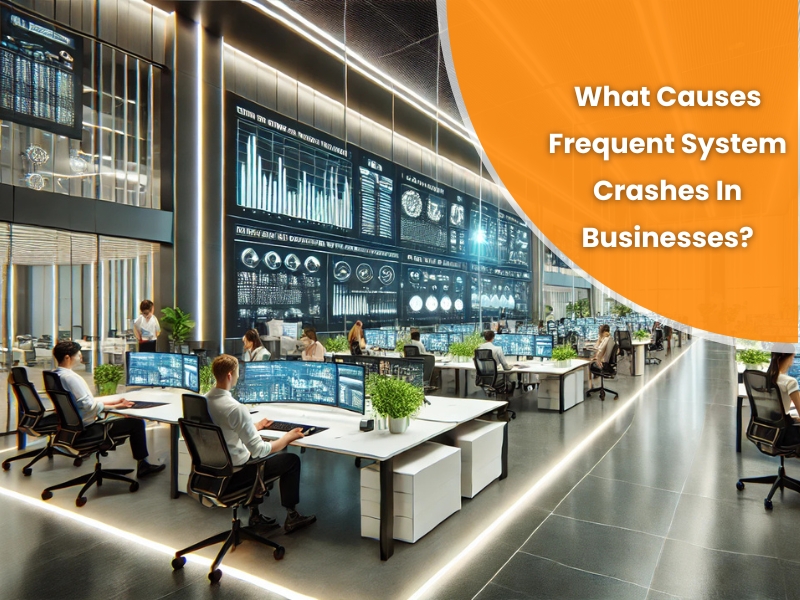In today’s fast-paced digital world, system crashes can bring businesses to a standstill, causing costly downtime and a significant loss in productivity. Frequent crashes can impact a company’s reputation and efficiency, mainly when left unaddressed. Understanding the underlying causes of these disruptions is the first step towards resolving them. This article explores the common causes of system crashes in businesses, how they affect operations, and how professional IT support can prevent these issues from recurring.
What are the most common causes of system crashes in your business?
System crashes can happen for a range of reasons. Some of the most common causes include:
- Outdated hardware: As technology advances, older hardware may need help keeping up, leading to frequent failures.
- Software issues: Incompatibilities between software or outdated versions can lead to system instability.
- Insufficient IT security: With solid security measures, systems are protected from cyberattacks, which can cause crashes.
- Poor network connectivity: Slow or unstable networks can interfere with business operations, leading to system failures.
- Viruses and malware: Malicious software can cause disruptions by corrupting files and overwhelming systems.
How can outdated hardware lead to frequent system failures?
Your hardware is the backbone of your entire IT infrastructure. Outdated computers, servers, or other hardware may need help to meet modern software demands, leading to frequent failures. Here’s how outdated hardware can cause system crashes:
- Slower performance: Older systems may have slower processing speeds, making it difficult to run multiple programs or handle complex tasks.
- Increased risk of hardware failure: Over time, hardware components degrade. Hard drives, memory, and other components may fail, causing system crashes.
- Incompatibility with newer software: As software updates are released, older hardware may struggle to support them, causing software crashes or system freezes.
- Lack of security updates: Outdated hardware may no longer receive security patches, leaving systems vulnerable to cyberattacks.
Could software incompatibilities be behind your business system crashes?
Software issues are another leading cause of system crashes. If the software running on your systems isn’t compatible with your hardware or other software applications, it can lead to instability. Here’s how software incompatibilities can cause problems:
- Software conflicts: When two or more programs try to access the same system resources simultaneously, they can conflict, leading to crashes.
- Outdated software versions: Running obsolete software can make it harder to maintain compatibility with newer operating systems and applications, causing performance issues.
- Improper configurations: Incorrect software configurations can lead to crashes, significantly if settings are misaligned with business needs.
- Need for more system resources: Software that requires more memory or processing power than your system can handle will lead to slowdowns and system crashes.
What role does insufficient IT security play in system stability?
Without robust IT security measures, your business is vulnerable to various threats that can compromise system stability. These threats may not only cause immediate crashes but also lead to long-term damage. Here’s how poor security can lead to system failures:
- Cyberattacks: Ransomware, viruses, and malware can overwhelm systems, corrupt files, and disrupt operations, leading to frequent crashes.
- Data breaches: A security breach can expose sensitive data and cause severe damage to your system, leading to the need for system reboots or replacements. Furthermore, implementing strong data breach prevention measures is crucial for safeguarding your business from potential cyber threats and protecting sensitive information.
- Unpatched vulnerabilities: Without regular security updates and patches, your systems may become susceptible to attacks that cause crashes.
- Phishing and social engineering: Employees falling for phishing attacks may unknowingly download malicious software, which can crash your systems.

How does poor network connectivity contribute to frequent system issues?
Network issues are another common cause of system failures. Whether you’re working with local area networks (LAN) or cloud-based systems, poor connectivity can lead to disruptions that affect business operations. Here’s how poor network connectivity can contribute to system crashes:
- Slow internet speeds: Slow internet connections can delay data transfer and processing, causing software to freeze or crash.
- Intermittent connection: If your business relies on cloud services, a poor or unstable connection can disrupt access to critical files and applications, resulting in crashes.
- Network overload: Too many devices connected to your network can cause congestion, slow performance, and system instability.
- Wi-Fi issues: Weak or unstable Wi-Fi signals can cause delays or prevent devices from connecting to the network.
Could viruses and malware be the hidden culprits of system crashes?
Viruses and malware are a common yet often overlooked cause of system crashes. Malicious software can compromise the integrity of your business systems, causing them to freeze, crash, or behave unpredictably. Here’s how viruses and malware can lead to system failures:
- Corruption of files: Malware can corrupt critical system files, causing applications and entire systems to crash.
- Overloading system resources: Some malware runs in the background, using valuable system resources like CPU and memory, leading to slowdowns and crashes.
- Data loss: Viruses may delete or encrypt essential files, leading to system instability and crashes.
- Spreading infections: If a virus spreads across multiple devices, it can cause a network-wide disruption, leading to widespread system failures.
How can professional IT support prevent and resolve system crashes?
Having reliable IT support to prevent system crashes is essential for maintaining business continuity. Here’s how:
- Proactive monitoring: IT professionals monitor systems for potential issues, identifying problems before they escalate into crashes.
- Troubleshooting expertise: When crashes occur, an experienced IT team can quickly identify and resolve the root cause, minimising downtime.
- Software and hardware optimisation: IT support ensures that software and hardware are optimised for peak performance, reducing the chances of system failures.
- Security management: A managed IT service will keep your systems secure with regular updates, patches, and malware protection.

How can proactive IT maintenance help prevent system failures in your business?
Proactive IT maintenance is vital to ensuring the long-term stability of your systems. By staying ahead of potential issues, you can prevent costly disruptions. Here’s how proactive IT maintenance can help:
- Regular system updates: Keeping software and hardware up to date reduces the risk of incompatibilities and security vulnerabilities.
- Hardware checks: Scheduled hardware inspections can identify failing components before they lead to crashes.
- Backup and recovery solutions: Regular data backups ensure that your data can be recovered without significant setbacks in the event of a failure.
- Network optimisation: Ongoing network monitoring ensures your systems run smoothly and without interruption.
Get IT support for your business with Kangaroo IT!
If you’re tired of dealing with system crashes and IT issues, it’s time to partner with a professional IT support team. Kangaroo IT provides comprehensive IT solutions for businesses in Sydney, ensuring that your systems are running smoothly and securely. From proactive maintenance to expert troubleshooting, our team is here to help your company avoid downtime and keep operations running smoothly.
Reach out to Kangaroo IT today to learn more about how we can support your business.

